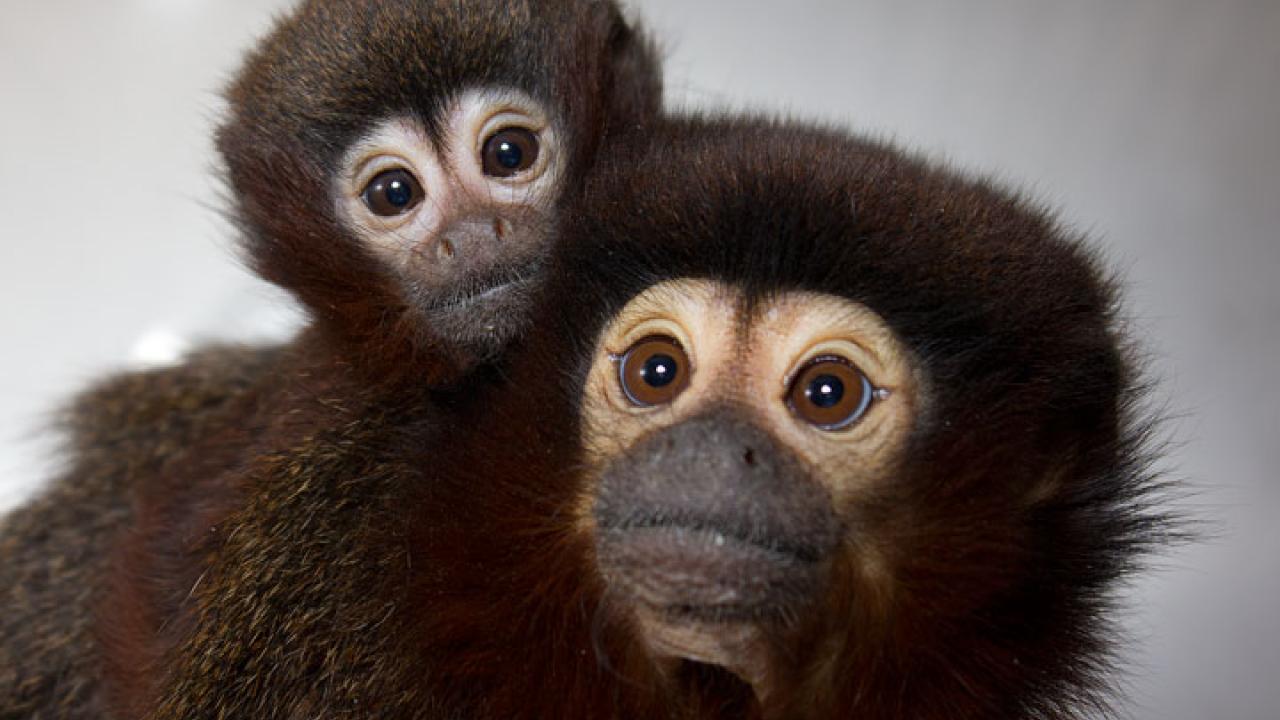
Male and Female Titi Monkeys Exhibit Different Biological and Behavioral Responses to Intranasal Oxytocin
Biological and Behavioral Responses to Intranasal Oxytocin
A series of studies published by Dr. Karen Bales’ lab at the California National Primate Research Center revealed that chronic intranasal oxytocin (OT) produces sex-specific biological and behavioral responses in titi monkeys, a monogamous nonhuman primate.
Karen Bales and former graduate student Rocío Arias-del Razo found that all OT-treated monkeys engaged more in social interactions, but where they directed their social behavior differed by sex. OT-treated males exhibited more social interest in unfamiliar animals, while females directed their enhanced social behavior toward their parents. As the first long-term study of chronic intranasal oxytocin treatments given during primate adolescence, these findings emphasize the complexity of the treatment and lay an important foundation for more research on its use in humans.
Intranasal oxytocin is a treatment used to reduce social impairment in several neurological behavioral disorders, such as autism. However, the long-term effects and efficacy of the treatment are currently under examination.
For the first time in primates, Karen Bales and Rocío Arias-del Razo examined the long-term effects of non-invasive intranasal OT treatment during adolescence in male and female titi monkeys. Much like humans, titi monkeys form an attachment with their parents during infancy, and when they reach adulthood, that bond transitions to a monogamous par bond with their mate. The similarity of these social bonds to those experienced by humans from infancy to adulthood makes them a powerful model for developmental disorders.
Bales and Arias-del Razo divided the monkeys into two groups: one received a daily dose of intranasal OT (treatment), and the other received a daily dose of saline (control) for six months. They found that intranasal OT doses affected titi monkey social behavior immediately following the dose, chronically during the dosing period, and into adulthood. Similar to findings in human studies, the treatment group exhibited more prosocial behavior in their home enclosure immediately following their dose than the control group.
The immediate effects [of intranasal OT] were prosocial, that was very interesting to see in monkeys, and suggests humans could have similar long-term effects to the treatment as the ones we found in our studies - Arias-del Razo.
Arias-del Razo also examined neural effects and social behavior during adolescence and then in adulthood one-year after treatment ended. In socially challenging situations, sex differences within the treatment group became very apparent at both time points. As juveniles, males from the treatment group exhibited increased social interest when exposed to strangers. There did not appear to be any effect on juvenile female social behavior in the same context. Interestingly, the juvenile males also showed increased anxiety-like behavior.
“If we just take a step back, I mean that’s what we’re seeing is major sex differences,” said Bales. As adults, a year after Arias-del Razo had stopped administering intranasal OT, males from the treatment group maintained some of the prosocial effects. They also scored higher on several measures of affiliative behavior than the control group. Females, however, experienced a slight delay in forming a bond with their new mate. To investigate possible long-term effects on the functionality of the oxytocin system and social behavior, Arias-del Razo administered either an acute dose of oxytocin or saline and briefly separated subjects from their mates. Observing the animals’ response to the separation revealed two things: chronic treatments during adolescence altered their behavior long-term, and these behavioral changes were different for males and females. These findings indicate a need for more research on chronic intranasal OT in primates.
Collaborator on the project, Dr. Suma Jacob from University of Minnesota Medical School, explained that, “people know there is more research to be done on oxytocin…but there may be limited funding coming into this area.” Research often targets discovering a particular drug for a very specific population. Jacob cautions this motivates, “doing the science towards [a treatment] as opposed to doing the science to understand how a biopsychosocial system really works. There is much more we need to learn about oxytocin, how it works, its effects, and feedback systems.”
Bales and Arias-del Razo have seen an overarching theme; intranasal oxytocin affects male and female primates differently. Their work shows some optimism for the treatment, but mostly, Arias-del Razo believes their study “highlights the urgent need of looking at the long-term effects [of chronic intranasal oxytocin treatments] in humans.”
People know there is more work that needs to be done…but there may be limited funding coming into this area.… There is much more we need to learn about oxytocin, how it works, its effects, and feedback systems - Jacob
Publications discussed in this article:
Arias-del Razo, R., et al. (2020). Effects of chronic intranasal oxytocin on behavior and cerebral glucose uptake in juvenile titi monkeys. Psychoneuroendocrinology, 113, 104494.
Arias-del Razo, R., et al. (2022). Long-term effects of chronic intranasal oxytocin on adult pair bonding behavior and brain glucose uptake in titi monkeys (Plecturocebus cupreus). Hormones & Behavior, 140, 105126
Arias-del Razo, R., de Lourdes Velasco Vasques, M., Turcanu, P., Legrand, M., Lau, A.R., Weinstein, T. A. R., Goetze, L. R. & Bales, K. L. (2022). Effects of chronic and acute intranasal oxytocin treatments on temporary social separation in adult titi monkeys (Plecturocebus cupreus). Frontiers in Behavioral Neuroscience, 16, 877631.
Written by: Logan Savidge
Media contact: Messiah Foster | mfoster@ucdavis.edu
